Fermentation…..What is it and can it be beneficial to my health?
LeAnne Calderon, UC Master Food Preserver, San Joaquin County
Kombucha, Kefir, Sauerkraut and other fermented foods are becoming more popular in the natural food markets. What are these products and how are they made? Fermented foods have been around for thousands of years. Eastern Europeans would put up as many as 300 heads of cabbage for their clan. The cabbage would be salted and allowed to ferment for use over the winter. Kombucha has been brewed for thousands of years as well. Many Americans have just become familiar with the beverage in the last few years as it has become available in local supermarkets. Kefir is another fermented product that has been around for centuries.
Fermentation is the process where microorganisms are encouraged to grow in foods producing desirable changes in flavor, texture and appearance. The two most common types of fermentation used for food consumption are (1) ethanol, used in kombucha and sourdough bread and (2) lactic acid, used to flavor and preserve fruits and vegetables.
Kombucha is the conversion of tea and sugar by a SCOBY (Symbiotic Culture of Bacteria and Yeast). The scoby feeds on the sugar and releases probiotic bacteria. The kombucha becomes carbonated after the fermentation. Sauerkraut and pickles are fermented in a brine solution of water and salt. Lactic acid is produced by bacteria during fermentation of the natural sugars. (see this article from Colorado State University: https://fsi.colostate.edu/kombucha/)
There are many claims for the health benefits of fermented foods. Currently, there are many studies being performed to prove these claims…they boost your immune system, fight the flu, have antioxidant properties, probiotics, etc. One current article found that research has found fermented foods to have a higher bioactive molecule content and found improved antioxidant activity in fermented milks, cereals, fruit and vegetables, meat and fish. Anti-hypertensive peptides were detected in fermented milk and cereals. The article concluded that the occurrence of healthy components and the activity thereof make fermented foods worthy of recommendation of regular consumption and inclusion in worldwide dietary guidelines. They go on to state that more research needs to be done in clinical trials to measure the effects in the different groups of the population. (1) This article is just one of many that are beginning to look at the benefits of fermented foods.
While the scientists are hard at work researching fermented foods, there are plenty of safe, tested recipes you can try at home to get started on your own fermentation journey. The health claims can only be speculated at the current time until more research is done, but we can still enjoy these tasty foods and enjoy eating fresh foods that we have prepared ourselves. Some links below for kombucha and sauerkraut can get you started. These tested recipes will assure the safety of your finished products.
Whether fermentation is something your family has been doing for generations or it is new to you, there are safe recipes for you to try to get started. In addition, washing your hands, sanitizing the food preparation area and using proper food preservation methods all are part of producing safe food products. Your local Master Food Preservers can answer your questions if you are unsure of any part of the food preservation process. Some good sources are the USDA Complete Guide to Home Canning, National Center for Home Food Preservation or your local UC Master Food Preservers. To get you started, linked below is a recipe for Sauerkraut and Kombucha.
Happy fermenting and be on the lookout for further research on the health claims of these delicious fermented foods!
Sauerkraut recipe https://nchfp.uga.edu/how/can_06/sauerkraut.html
Kombucha recipe https://foodsmartcolorado.colostate.edu/recipes/preservation/understanding-and-making-kombucha/
Health-Promoting Components in Fermented Foods: An Up-to-Date Systematic Review
Francesca Melini, Valentina Melini, Francesca Luziatelli, Anna Grazia Ficca, Maurizio Ruzzi
Nutrients. 2019 May; 11(5): 1189. Published online 2019 May 27. doi: 10.3390/nu11051189
PMCID: PMC6567126
Photo: Colorado State University